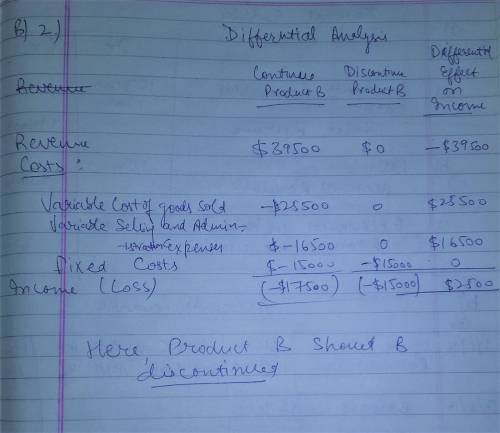
Product A is normally sold for $9.60 per unit. A special price of $7.20 is offered for the export market. The variable production cost is $5.00 per unit. An additional export tariff of 15% of revenue must be paid for all export products. Assume that there is sufficient capacity for the special order. Prepare a differential analysis dated March 16 on whether to reject (Alternative 1) or accept (Alternative 2) the special order. Round your answers to two decimal places. If an amount is zero, enter "0". For those boxes in which you must enter subtracted or negative numbers use a minus sign. Differential Analysis Reject Order (Alt. 1) or Accept Order (Alt. 2) March 16 Reject Order (Alternative 1) Accept Order (Alternative 2) Differential Effect on Income (Alternative 2) Revenues, per unit $ $ $ Costs: Variable manufacturing costs, per unit Export tariff, per unit Income (Loss), per unit $ $ $ Should the special order be rejected (Alternative 1) or accepted (Alternative 2)?

Answers: 2
Another question on Business

Business, 21.06.2019 21:30
Balance sheet baggett company's balance sheet accounts and amounts as of december 31, 2016, are shown in random order as follows: account debit (credit) account debit (credit) income taxes payable $(3,800) additional paid-in capital on preferred prepaid items 1,800 stock $(7,900) additional paid-in capital on common stock (9,300) allowance for doubtful accounts (1,600) land 12,200 bonds payable (due 2020) (23,000) notes payable (due 2019) (6,000) buildings 57,400 notes receivable (due 2018) 16,400 sinking fund to retire bonds payable 5,000 accounts receivable 12,600 advances from customers (long-term) (2,600) premium on bonds payable (1,400) cash 4,300 accounts payable (13,100) accumulated depreciation: equipment (9,700) inventory 7,400 retained earnings (18,300) accumulated depreciation: buildings (21,000) preferred stock, $100 par (18,600) patents (net) 4,600 wages payable (1,400) equipment 28,700 common stock, $10 par (12,700) required: 1. prepare a december 31, 2016 balance sheet for the baggett. baggett company balance sheet december 31, 2016 assets current assets: $ $ $ long-term investments: $ property, plant, and equipment: $ $ $ intangible assets: liabilities current liabilities: $ $ long-term liabilities: $ $ other liabilities: shareholders' equity contributed capital: $ $ $ $ 2. compute the debt-to-assets ratio. round to one decimal place. do not enter a percent sign (%) as part of your answer. %
Answers: 1

Business, 22.06.2019 03:00
Presented below is a list of possible transactions. analyze the effect of the 18 transactions on the financial statement categories indicated. transactions assets liabilities owners’ equity net income 1. purchased inventory for $80,000 on account (assume perpetual system is used). 2. issued an $80,000 note payable in payment on account (see item 1 above). 3. recorded accrued interest on the note from item 2 above. 4. borrowed $100,000 from the bank by signing a 6-month, $112,000, zero-interest-bearing note. 5. recognized 4 months’ interest expense on the note from item 4 above. 6. recorded cash sales of $75,260, which includes 6% sales tax. 7. recorded wage expense of $35,000. the cash paid was $25,000; the difference was due to various amounts withheld. 8. recorded employer’s payroll taxes. 9. accrued accumulated vacation pay. 10. recorded an asset retirement obligation. 11. recorded bonuses due to employees. 12. recorded a contingent loss on a lawsuit that the company will probably lose. 13. accrued warranty expense (assume expense warranty approach). 14. paid warranty costs that were accrued in item 13 above. 15. recorded sales of product and related service-type warranties. 16. paid warranty costs under contracts from item 15 above. 17. recognized warranty revenue (see item 15 above). 18. recorded estimated liability for premium claims outstanding.
Answers: 1

Business, 22.06.2019 16:00
Three pounds of material a are required for each unit produced. the company has a policy of maintaining a stock of material a on hand at the end of each quarter equal to 30% of the next quarter's production needs for material a. a total of 35,000 pounds of material a are on hand to start the year. budgeted purchases of material a for the second quarter would be:
Answers: 1

Business, 23.06.2019 02:30
Zendor company wants to have $200,000 available in august 2021 to make an equipment purchase. to be able to have this amount available, zendor will make equal annual deposits in an investment account earning 12% annually in june 2017, 2018, 2019, 2020, and 2021. what is the dollar amount that must be deposited each of those years to achieve this objective?
Answers: 3
You know the right answer?
Product A is normally sold for $9.60 per unit. A special price of $7.20 is offered for the export ma...
Questions

Geography, 21.10.2019 16:50

Mathematics, 21.10.2019 16:50

Mathematics, 21.10.2019 16:50


History, 21.10.2019 16:50





Biology, 21.10.2019 16:50


Chemistry, 21.10.2019 16:50






Mathematics, 21.10.2019 16:50


Biology, 21.10.2019 16:50





